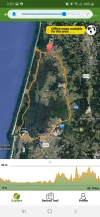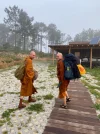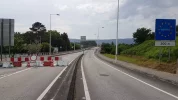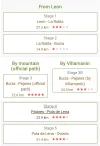Good morning!
Today is going to be an easy day, only 28 kilometers downhill, no alms round and it's supposed to be sunny, so I can splurge a bit on my phone battery and recharge it later.
So I thought I would go ahead and give you some idea of what is happening on the camino more generally since I left Santiago.
For the first three days up to Sarriah, I met quite a lot of pilgrims, I would say at least 10 to 15 people each day. Usually at least two of them walking together but also groups of up to 5 or 6 people. Most of them didn't carry more than a day pack so they could have been just out for the day but about a handful carried something more hefty and I think were bound for Santiago. Sadly though, there was rarely more of an exchange than 'Hola!', 'Hola!', 'Bon Camino!' and 'Gracias!', so I couldn't really tell where they were from. Since I don't speak Spanish myself, I reverted to saying 'Hello!' 'Good Morning!' and 'Enjoy your walk!' In this way I managed to stop and talk for a minute to a Spanish couple who had started the their journey in Burgos and a Swiss woman who had just left from Sarriah that very morning.
After I had moved through that city the numbers of pilgrims dropped substantially and it seems to me, that this place is a bit of a starting point to Santiago if one only has a week or so and wants to stay a couple days at the final destination as well.
So in the last 3 days I met four to five walkers on average. The ones that I talked to were a German who had started in Pamplona, one from Slovakia who walked from St. Jean. I also talked to two Spanish guys yesterday but forgot to ask where they had left from.
It comes to me as a bit of a surprise, that even though most of the pilgrims who walk this year are Spanish, there seem to be more foreigners walking than I had expected. Although, I don't know what kind of 'traffic' there is in normal years, I guess it must be quite a lot more.
Walking through the villages and towns, I get the feeling, that they must really hurt, being in their second year without income from the stream of pilgrims injecting money into the local communities. There are 'se vende' signs on sooo many buildings and properties.
I sometimes think about what aspects of me walking especially in this year and in 'the wrong direction' of the
Camino Frances' would have been harder and which are the ones that would be easier compared to a 'normal' year.
One thing that would have defenitely been harder I think is to stealth camp. For example, since I am in this mountainous region with rarely a flat space, I pitched my tent less then two meters from the trail last night around 8 pm. It's now 12 hours later and no one has gone by my tent. I never climb over a fence to pitch my tent but I'm sure quite a few places I have slept on were meadows, forests or tree plantations that are privately owned. And if a farmer or owner has ever spotted me that I am not aware of, no one has has come to my tent so far to ask me what I am thinking of doing here or to kick me out. Knock on wood.
What seems to be easier and doesn't seem to be possible at all for me this year, is to team up with some other pilgrim that one meets along the way. This year, there are rarely any and they all walk towards Santiago. Having said that, there seems to be a tendency to team up as I have experienced that with my Portuguese pilgrim friend Fernando, who I met and walked with for a couple days before we reached the Spanish border. And also the German and the Slovakian had just met a day prior and it looked likely that they would end the walk in Santiago together. So what do you think, is teaming up normal?
The last big item is about alms round. Since Sarriah, I didn't bother to stand for alms food twice (the day after Sarriah and today) because the little hamlets I could be standing in are basically deserted and the one or two shops there are either closed or have so few patrons that the likelihood of me receiving food would almost solely depend on the shop owner taking a pity in me.
In the bigger towns and cities I do stand, it takes really long to get my bowl filled with food for the day. Some two hours or more I will have to stand on average which is substantially longer than in Portugal. This might be for a few reasons. One, is the size of the supermarkets. While in Portugal they have a lot of the medium sized chains (Continente, Lidl, etc.) and people are much more willing to go back inside after they hear that I can't take their money. In Spain, you have either the super stores like Carrefour (no one in their right mind is going in there twice in a row) or many small shops in one city (Coviran, etc.) so the stream of customers is rather low because they are so widely distributed.
Also, the Spanish people seem to be more in a rush and while they average the Portuguese in the numbers who want to give money, only about 10 to 15 percent of the Spanish are going to get some food after I decline compared to the Portuguese where about 80 percent of the ones after hearing that I only take food will go and buy some. As you can see, there is a lot of time working out theories when one stands for two hours in front of a supermarket each day...

Well, it's eight thirty in the morning now, my latest start ever in the last 32 days. I usually start walking around 7 am. Still, no one has passed my tent but it's time to get packing.
Tan Viranando





























